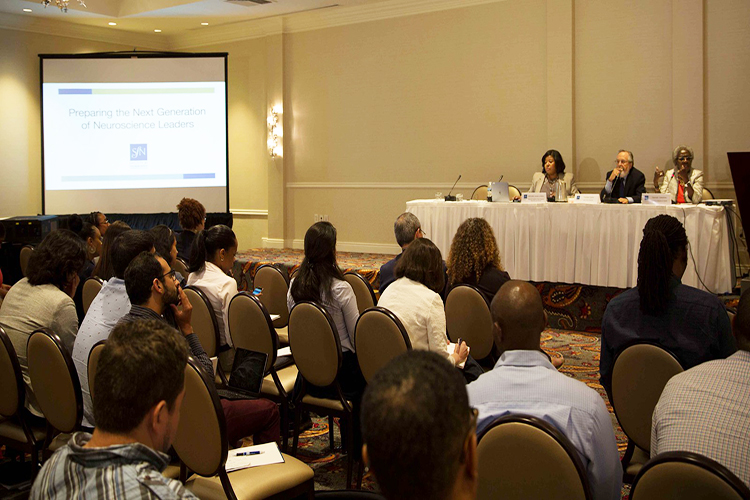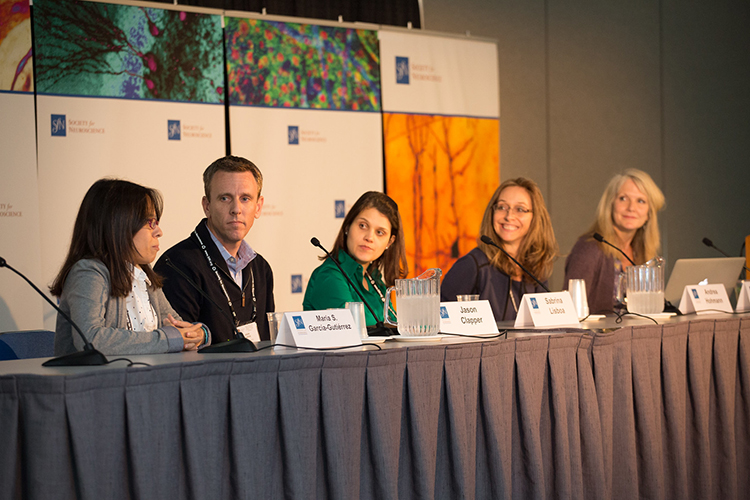
SfN, NIH Experts Discuss How Diversity Advances the Field

Hannah Valantine, NIH’s chief officer for scientific workforce diversity; Thomas J. Carew, Dean of the Faculty of Arts and Science at NYU and a past SfN president; and Michelle D. Jones-London, chief of the NINDS Office of Programs to enhance Neuroscience Workforce Diversity, take part in SfN's dialogue.
Throughout his career in neuroscience, SfN President Eric Nestler has heard fellow scientists from underrepresented groups in the field talk about the additional challenges they faced and the dedication they required in order to successfully navigate their careers. “As a result, I feel a great sense of responsibility to the next generation of neuroscientists … in ensuring that all aspiring neuroscientists have the opportunity to pursue their passion — regardless of their gender, race, culture, or background — and thrive in their careers,” Nestler said.
Speaking before the opening session of SfN’s first-ever Neuroscience Scholars Program (NSP) conference in July, Nestler addressed not only the program’s young participants but a broad audience of the neuroscience community watching remotely. While the program and conference aim to foster the careers of graduate students and postdoctoral fellows from groups underrepresented in science, the conference’s opening session, recorded and available for viewing on Neuronline, was directed at all scientists and welcomed leaders in the field for a dialogue on how diversity advances science and why communities should continue to work for inclusion.
“We need a diverse community of dedicated scientists and physicians who can formulate new, innovative solutions that have eluded us,” Nestler said. “Not only does this benefit our field, but society is far better off when we include the full range of our population when searching for answers to the major challenges of our time.”
He emphasized an urgent call for greater progress in the recruitment and retention of women and underrepresented groups in science and noted that “affirmative attention” is needed on these systemic issues to achieve more diversity in the field.
The session’s panelists who addressed these diversity challenges and potential solutions included speakers from dynamic academic and professional backgrounds:
- Hannah Valantine, NIH’s first-ever chief officer for scientific workforce diversity
- Thomas J. Carew, the Anne and Joel Ehrenkranz Dean of the Faculty of Arts and Science at NYU and a past SfN president
- Michelle D. Jones-London, chief of the Office of Programs to enhance Neuroscience Workforce Diversity at the NIH’s National Institute of Neurological Disorders and Stroke (NINDS)
Valantine, whose NIH office engages partners from academia and industry to achieve diversity at all career levels in biomedical research, discussed how progress in achieving greater workforce diversity requires the engagement of leaders at academic institutions. As a dean at a university, Carew spoke from the institutional perspective, describing his efforts to make NYU a leader in recruitment and diversity, including the creation of a Faculty Diversity Toolkit. Jones-London, chief of the office that administers the NSP grant, served as the moderator for the session. As chair of the the NINDS Diversity Working Group, she plays a lead role in the establishment of networks and partnerships to increase neuroscience workforce diversity.
In his remarks, Nestler also spoke about the work that SfN is doing to improve diversity in the field. In addition to the Neuroscience Scholars Program, SfN has a Latin American Training Program (LATP) that provides professional development and networking opportunities for young investigators from the Latin America and Caribbean region. SfN has also created four Increasing Women in Neuroscience (IWiN) toolkits focused on addressing implicit bias and improving diversity in the field. Read more about SfN’s diversity efforts in Nestler’s Message From the President in the Spring edition of Neuroscience Quarterly.






















